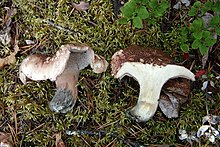| Hydnellum scabrosum | |
|---|---|

| |
| Scientific classification | |
| Domain: | Eukaryota |
| Kingdom: | Fungi |
| Division: | Basidiomycota |
| Class: | Agaricomycetes |
| Order: | Thelephorales |
| Family: | Bankeraceae |
| Genus: | Hydnellum |
| Species: | H. scabrosum |
| Binomial name | |
| Hydnellum scabrosum (Fr.) E.Larss., K.H.Larss. & Kõljalg | |
| Synonyms | |
|
Sarcodon scabrosus (Fr.) P. Karst. | |
| Hydnellum scabrosum | |
|---|---|
| Teeth on hymenium | |
| Cap is convex or flat | |
| Hymenium is subdecurrent or adnate | |
| Stipe is bare | |
| Spore print is brown | |
| Ecology is mycorrhizal | |
| Edibility is inedible | |
Hydnellum scabrosum, also called bitter tooth or bitter hedgehog, is a species of tooth fungus in the family Bankeraceae.
Taxonomy
It was originally described by Swedish botanist Elias Fries as Hydnum scabrosum in 1836. Finnish mycologist Petter Karsten moved it to the genus Sarcodon in 1881. This species remained as Sarcodon scabrosus until 2019, when a molecular analysis using nuclear DNA showed that this and 11 other species lay genetically within the genus Hydnellum, a genus of which harder woody flesh had previously been considered a distinguishing feature from soft-fleshed Sarcodon.
Within the genus it is most closely related to H. fennicum.
Description
The fruit body (mushroom) has a convex to flattened brownish cap up to 12 cm (4+3⁄4 in) across that is covered with brown scales. It can be tinged with pink at the margins and darken with age. The mushroom has yellow-brown spines under the cap that are 5 mm (1⁄4 in) long and 0.3 mm (1⁄64 in) in diameter. They are decurrent to the stem. The pinkish brown stem is 2–12 cm (3⁄4–4+3⁄4 in) high and 1–6 cm (3⁄8–2+3⁄8 in) wide, and has a narrower base that is a characteristic greyish green colour. The flesh is whitish and has a bitter taste, rendering the mushroom inedible. The flesh smells farinaceous or like watermelon when cut.
Distribution and habitat
It is found in association with hardwood forests across Eurasia to Japan, as well as North America.
Biochemistry
The species has been investigated for bioactive agents. In 2004, Tsunashi Kamo and colleagues isolated diterpenoids with experimental anti-inflammatory activity. Other diterpenoids were shown to stimulate nerve growth factor (NGF). Yet another agent, an alpha-pyrone, was shown to inhibit lettuce seedling growth.
Similar species
Sarcodon imbricatus is similar, but the scales do not become as prominent in age. Other similar species include S. fennicus, S. rimosus, S. subincarnatus, and S. underwoodii.
References
- ^ Larsson; Svantesson; Miscevic; Kõljalg; Larsson (2019). "Reassessment of the generic limits for Hydnellum and Sarcodon (Thelephorales, Basidiomycota)". MycoKeys (54): 31–47. doi:10.3897/mycokeys.54.35386. PMC 6579789. PMID 31231164.
- ^ Trudell, Steve; Ammirati, Joe (2009). Mushrooms of the Pacific Northwest. Timber Press Field Guides. Portland, OR: Timber Press. p. 235. ISBN 978-0-88192-935-5.
- Marcotullio, Maria Carla (2011). "Sarcodon Mushrooms: Biologically Active Metabolites". In Iraj Rasooli (ed.). Phytochemicals Bioactivities and Impact on Health. pp. 84–85. ISBN 978-953-307-424-5.
- ^ Endo, Yasuhisa; Minowa, Akira; Kanamori, Ryo; Araya, Hiroshi (2012). "A rare α-pyrone from bitter tooth mushroom, Sarcodon scabrosus (Fr.) Karst". Biochemical Systematics and Ecology. 44: 286–288. doi:10.1016/j.bse.2012.06.018.
- Kamo, Tsunashi; Imura, Yuki; Hagio, Tomomi; Makabe, Hidefumi; Shibata, Hisao; Hirota, Mitsuru (2004). "Anti-inflammatory Cyathane Diterpenoids from Sarcodon scabrosus". Bioscience, Biotechnology, and Biochemistry. 68 (6): 1362–1365. doi:10.1271/bbb.68.1362. PMID 15215604. S2CID 27553869.
- Kita, Takako; Takaya, Yoshiaki; Oshima, Yoshiteru; Ohta, Tomihisa; Aizawa, Koichi; Hirano, Takaaki; Inakuma, Takahiro (1998). "Scabronines B, C, D, e and F, novel diterpenoids showing stimulating activity of nerve growth factor-synthesis, from the mushroom Sarcodon scabrosus". Tetrahedron. 54 (39): 11877–11886. doi:10.1016/S0040-4020(98)83045-7.
| Taxon identifiers | |
|---|---|
| Hydnellum scabrosum | |
| Sarcodon scabrosus | |
| Hydnum scabrosum | |